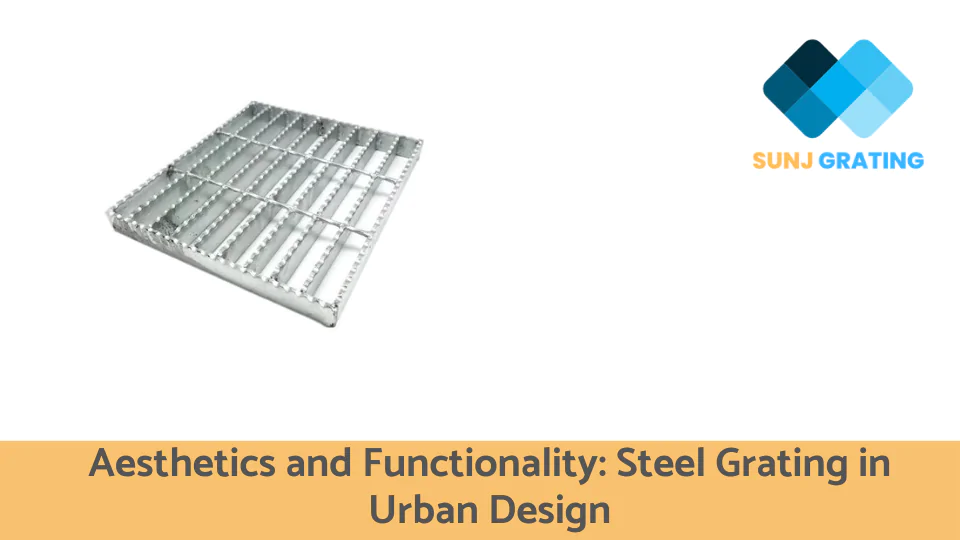Have you ever walked through a city and marveled at the intricate designs beneath your feet, only to realize they’re not just for show? The blend of aesthetics and functionality in urban design is a delicate dance, and steel grating plays a pivotal role in this choreography. Often overlooked, these grates serve more than a utilitarian purpose; they’ve become an integral part of the urban landscape, marrying form and function seamlessly.
Steel grating in urban design is not just about providing a sturdy surface or ensuring proper drainage. It’s about enhancing the visual appeal of our cities while ensuring they remain functional and safe. As urban spaces evolve, the importance of elements like steel grating that offer both beauty and utility cannot be overstated.
By the end of this article, you’ll gain a deeper appreciation for these seemingly mundane fixtures and understand their significance in shaping aesthetically pleasing and efficient urban environments. So, let’s dive in and explore the world of steel grating in urban design.
Aesthetics of Steel Grating

The Visual Appeal of Steel Grating: Patterns, Finishes, and Designs
Patterns
Steel grating’s versatility in patterns is one of its standout aesthetic features. Depending on the design intent, architects and planners can choose from a variety of patterns. Simple straight lines offer a minimalist look, while intricate geometric designs can create more complex visual effects.
Popular choices include diamond and rectangular patterns, but the possibilities don’t end there. Custom patterns tailored to specific design visions can also be crafted, allowing for a unique look that can be a focal point or blend seamlessly with the surroundings.
Finishes
Beyond its structural benefits, the finish applied to steel grating plays a pivotal role in its visual appeal. Traditional galvanized finishes remain popular for their shiny, metallic look and durability. However, modern techniques have expanded the range of available finishes.
Powder coating, for instance, allows steel grating to be colored in a spectrum of hues, from muted earth tones to vibrant, standout colors. These finishes not only enhance the visual appeal but also offer added protection against rust and environmental wear.
Designs
The design of steel grating encompasses both its pattern and finish but also considers its overall integration into a space. For instance, how the grating is framed, its orientation, and even its level of transparency can all impact its aesthetic contribution to a space.
Designers might opt for a more transparent grating to give viewers a glimpse of what’s beneath, creating a layered visual experience. Alternatively, denser designs can be chosen for areas where more coverage is desired. The flexibility in design ensures that steel grating can be tailored to meet both functional and aesthetic requirements.

How Steel Grating Complements Modern and Traditional Architectural Styles
In modern architecture, steel grating offers a sleek, industrial look, often used in contemporary buildings and landscapes. Conversely, in traditional settings, it can be incorporated in a way that respects and enhances historical aesthetics, providing a bridge between the old and the new.
Case Studies: Iconic Urban Spaces
Several iconic urban spaces around the world have effectively incorporated steel grating to elevate their aesthetic appeal:
| The High Line in New York City | This elevated linear park, built on a historic freight rail line, uses steel grating extensively. The grating allows for water drainage, but its primary purpose is aesthetic. It provides a transparent surface that lets visitors see the structure beneath their feet, creating a unique visual experience. |
| Namba Parks in Osaka, Japan | This urban park and shopping complex features terraced gardens, where steel grating is used for walkways. The grating’s design allows for vegetation to grow beneath, creating a harmonious blend of nature and urban design. |
| The Tate Modern in London | The iconic art museum, housed in a former power station, features steel grating in various parts of the building. The grating not only serves functional purposes but also adds to the industrial aesthetic of the space, paying homage to the building’s history |
Functionality of Steel Grating

Drainage
One of the most recognized benefits of steel grating is its ability to facilitate efficient drainage. The gaps inherent in its design allow water to pass through easily, preventing the accumulation of surface water. This is especially crucial in urban areas where rapid water runoff from rain can lead to flooding. By using steel grating in areas like sidewalks, plazas, and driveways, cities can ensure that water is channeled away effectively, reducing the risk of flood-related damages and hazards.
Slip Resistance
Safety is paramount in public spaces, and steel grating contributes significantly in this regard. The textured surface of steel grating, combined with its inherent design, offers excellent slip resistance. Even when wet, the surface provides traction, reducing the likelihood of slips and falls. This makes steel grating an ideal choice for areas with high foot traffic, especially in regions prone to rain or snow.
Ventilation
In addition to drainage and slip resistance, steel grating plays a vital role in ventilation, especially in underground spaces like subways or parking garages. The open design of the grating allows for the free flow of air, ensuring that these spaces remain well-ventilated. This not only improves air quality but also helps in regulating temperature, making underground areas more comfortable for users.
Durability and Maintenance
Steel grating stands out for its durability. Made from high-strength steel, it is designed to withstand heavy loads, from pedestrians to vehicles. Its robust nature means it can resist the wear and tear of daily use, making it a long-lasting solution for urban infrastructure.
Moreover, steel grating requires minimal maintenance. Unlike other materials that might crack, warp, or degrade over time, steel grating retains its integrity for years. Occasional cleaning and inspections are generally all that’s needed to keep it in optimal condition. This low maintenance requirement, combined with its longevity, makes steel grating a cost-effective choice for cities, offering value over its lifespan.
Safety Considerations
Beyond its slip-resistant properties, steel grating offers several other safety benefits. Its design ensures that debris, like leaves or trash, doesn’t accumulate on the surface, reducing potential trip hazards. Additionally, its strength and durability mean that it can safely bear heavy loads, be it a crowd at an event or vehicles in a parking area.
Furthermore, in emergency situations, the permeability of steel grating can be beneficial. For instance, in the event of a fire in an underground space, the grating can allow smoke to escape, improving visibility and conditions for both evacuees and first responders.
Conclusion
Steel grating’s significance in urban design is undeniable. As we’ve explored, it’s not just about functionality but also about enhancing the beauty of our urban environments. As cities grow and change, the role of steel grating will undoubtedly expand, continuing to shape our urban landscapes in ways that are both aesthetically pleasing and functional.


